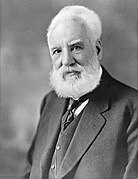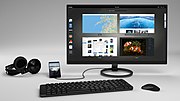Portal:Telephones

A telephone, colloquially referred to as a phone, is a telecommunications device that permits two or more users to conduct a conversation when they are too far apart to be easily heard directly. A telephone converts sound, typically and most efficiently the human voice, into electronic signals that are transmitted via cables and other communication channels to another telephone which reproduces the sound to the receiving user. The term is derived from Ancient Greek: τῆλε, romanized: tēle, lit. 'far' and φωνή (phōnē, voice), together meaning distant voice.
In 1876, Alexander Graham Bell was the first to be granted a United States patent for a device that produced clearly intelligible replication of the human voice at a second device. This instrument was further developed by many others, and became rapidly indispensable in business, government, and in households. (Full article...)

A mobile phone or cell phone is a portable telephone that can make and receive calls over a radio frequency link while the user is moving within a telephone service area, as opposed to a fixed-location phone (landline phone). The radio frequency link establishes a connection to the switching systems of a mobile phone operator, which provides access to the public switched telephone network (PSTN). Modern mobile telephone services use a cellular network architecture, and therefore mobile telephones are called cellphones (or "cell phones") in North America. In addition to telephony, digital mobile phones support a variety of other services, such as text messaging, multimedia messaging, email, Internet access (via LTE, 5G NR or Wi-Fi), short-range wireless communications (infrared, Bluetooth), satellite access (navigation, messaging connectivity), business applications, payments (via NFC), multimedia playback and streaming (radio, television), digital photography, and video games. Mobile phones offering only basic capabilities are known as feature phones (slang: "dumbphones"); mobile phones that offer greatly advanced computing capabilities are referred to as smartphones. (Full article...)
A smartphone, often simply called a phone, is a mobile device that combines the functionality of a traditional mobile phone with advanced computing capabilities. It typically has a touchscreen interface, allowing users to access a wide range of applications and services, such as web browsing, email, and social media, as well as multimedia playback and streaming. Smartphones have built-in cameras, GPS navigation, and support for various communication methods, including voice calls, text messaging, and internet-based messaging apps. (Full article...)
Android is a mobile operating system based on a modified version of the Linux kernel and other open-source software, designed primarily for touchscreen mobile devices such as smartphones and tablets. Android is developed by a consortium of developers known as the Open Handset Alliance, though its most widely used version is primarily developed by Google. It was unveiled in November 2007, with the first commercial Android device, the HTC Dream, being launched in September 2008.
At its core, the operating system is known as the Android Open Source Project (AOSP) and is free and open-source software (FOSS) primarily licensed under the Apache License. However, most devices run on the proprietary Android version developed by Google, which ships with additional proprietary closed-source software pre-installed, most notably Google Mobile Services (GMS) which includes core apps such as Google Chrome, the digital distribution platform Google Play, and the associated Google Play Services development platform. Firebase Cloud Messaging is used for push notifications. While AOSP is free, the "Android" name and logo are trademarks of Google, which imposes standards to restrict the use of Android branding by "uncertified" devices outside their ecosystem.
Over 70 percent of smartphones based on the Android Open Source Project run Google's ecosystem (which is known simply as Android), some with vendor-customized user interfaces and software suites, such as TouchWiz and later One UI by Samsung and HTC Sense. Competing ecosystems and forks of AOSP include Fire OS (developed by Amazon), ColorOS by Oppo, OriginOS by Vivo, MagicUI by Honor, or custom ROMs such as LineageOS. (Full article...)
Mobile radio telephone systems were mobile telephony systems that preceded modern cellular network technology. Since they were the predecessors of the first generation of cellular telephones, these systems are sometimes retroactively referred to as pre-cellular (or sometimes zero generation, that is, 0G) systems. Technologies used in pre-cellular systems included the Push-to-talk (PTT or manual), Mobile Telephone Service (MTS), Improved Mobile Telephone Service (IMTS), and Advanced Mobile Telephone System (AMTS) systems. These early mobile telephone systems can be distinguished from earlier closed radiotelephone systems in that they were available as a commercial service that was part of the public switched telephone network, with their own telephone numbers, rather than part of a closed network such as a police radio or taxi dispatching system.
These mobile telephones were usually mounted in cars or trucks (thus called car phones), although portable briefcase models were also made. Typically, the transceiver (transmitter-receiver) was mounted in the vehicle trunk and attached to the "head" (dial, display, and handset) mounted near the driver seat. They were sold through WCCs (Wireline Common Carriers, a.k.a. telephone companies), RCCs (Radio Common Carriers), and two-way radio dealers. (Full article...)Dual-tone multi-frequency signaling (DTMF) is a telecommunication signaling system using the voice-frequency band over telephone lines between telephone equipment and other communications devices and switching centers. DTMF was first developed in the Bell System in the United States, and became known under the trademark Touch-Tone for use in push-button telephones supplied to telephone customers, starting in 1963. DTMF is standardized as ITU-T Recommendation Q.23. It is also known in the UK as MF4. (Full article...)

- Comparison of smartphones
- List of best-selling mobile phones
- List of countries by number of broadband Internet subscriptions
- List of countries by number of telephone lines in use
- List of countries by smartphone penetration
- List of country calling codes
- List of iPhone models
- List of mobile network operators
- List of mobile phone brands by country
- List of mobile phone generations
- List of telecommunications companies
Pat Trumble Fleet is an American voice actress. Widely recognized for the tens of thousands of recordings she has made for US telephone companies such as AT&T, Verizon, Qwest, the former Bell System companies, and others since 1981, she is still most recognized as the person who says "AT&T" in the company's sound trademark, which played prior to any operator assisted or credit card paid call, and on answer when calling AT&T customer service numbers.
She is also the voice for most "star" services (e.g. last-call return, call blocking, etc.) for AT&T local telephone companies, and the voice heard when making AT&T handled calls through 1-800-CALL-ATT (225-5288) and through international AT&T access numbers such as USADirect. (Full article...)
 |
Here are some tasks awaiting attention:
|
Telephones in the news
- 20 July 2024 –
- The government of Equatorial Guinea suspends internet and telephone services on the separatist island of Annobón, with the Unrepresented Nations and Peoples Organization condemning the suspension. (Agencia NOVA)
- 19 July 2024 – 2024 Bangladesh quota reform movement
- The government of Bangladesh cut off internet, mobile phone, and TV broadcast services in the country, instituting a media blackout. (France 24)
The following Wikimedia Foundation sister projects provide more on this subject:
-
Commons
Free media repository -
Wikibooks
Free textbooks and manuals -
Wikidata
Free knowledge base -
Wikinews
Free-content news -
Wikiquote
Collection of quotations -
Wikisource
Free-content library -
Wikiversity
Free learning tools -
Wiktionary
Dictionary and thesaurus














































































































